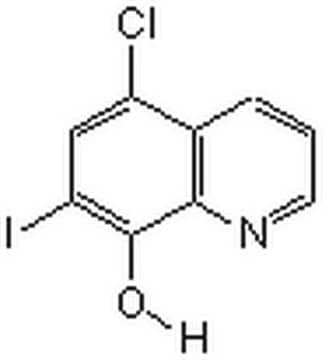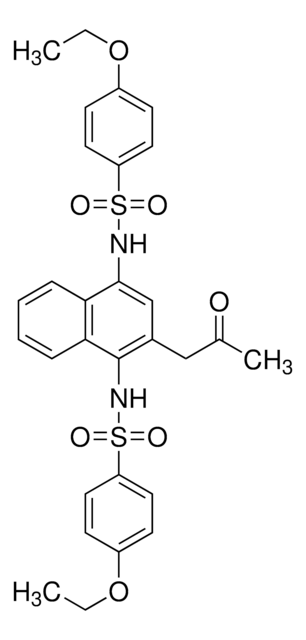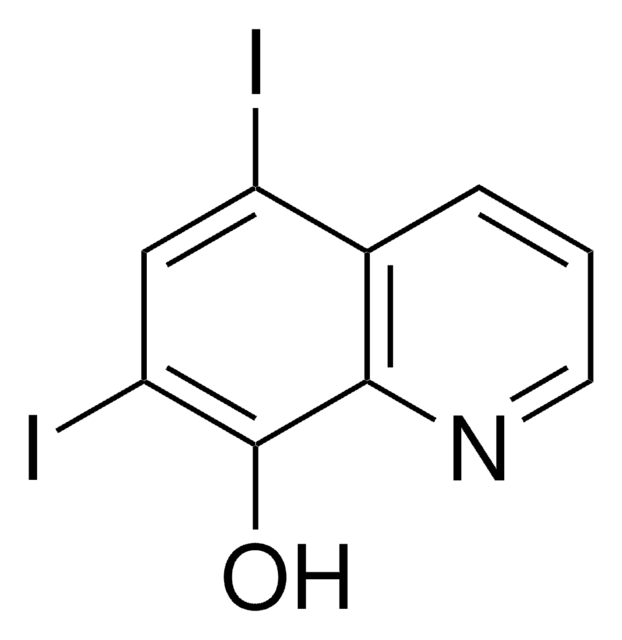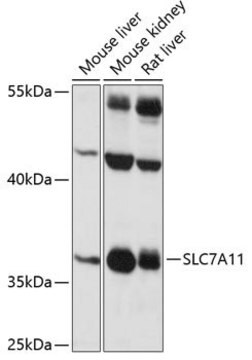Y0000364
Clioquinol
European Pharmacopoeia (EP) Reference Standard
동의어(들):
5-Chloro-7-iodo-8-quinolinol, 5-Chloro-8-hydroxy-7-iodoquinoline, Clioquinol, Iodochlorhydroxyquin
로그인조직 및 계약 가격 보기
모든 사진(1)
About This Item
실험식(Hill 표기법):
C9H5ClINO
CAS Number:
Molecular Weight:
305.50
Beilstein:
153637
MDL number:
UNSPSC 코드:
41116107
PubChem Substance ID:
NACRES:
NA.24
추천 제품
Grade
pharmaceutical primary standard
API family
clioquinol
제조업체/상표
EDQM
응용 분야
pharmaceutical (small molecule)
형식
neat
저장 온도
2-8°C
SMILES string
Oc1c(I)cc(Cl)c2cccnc12
InChI
1S/C9H5ClINO/c10-6-4-7(11)9(13)8-5(6)2-1-3-12-8/h1-4,13H
InChI key
QCDFBFJGMNKBDO-UHFFFAOYSA-N
유사한 제품을 찾으십니까? 방문 제품 비교 안내
일반 설명
This product is provided as delivered and specified by the issuing Pharmacopoeia. All information provided in support of this product, including SDS and any product information leaflets have been developed and issued under the Authority of the Issuing Pharmacopoeia. For further information and support please go to the website of the issuing Pharmacopoeia.
애플리케이션
Clioquinol EP Reference standard, intended for use in laboratory tests only as specifically prescribed in the European Pharmacopoeia.
포장
The product is delivered as supplied by the issuing Pharmacopoeia. For the current unit quantity, please visit the EDQM reference substance catalogue.
기타 정보
Sales restrictions may apply.
신호어
Danger
유해 및 위험 성명서
Hazard Classifications
Acute Tox. 3 Oral - Eye Irrit. 2 - Skin Irrit. 2 - Skin Sens. 1
Storage Class Code
6.1C - Combustible acute toxic Cat.3 / toxic compounds or compounds which causing chronic effects
WGK
WGK 3
Choose from one of the most recent versions:
시험 성적서(COA)
Lot/Batch Number
Sorry, we don't have COAs for this product available online at this time.
If you need assistance, please contact 고객 지원 부서
Lin W Hung et al.
Future medicinal chemistry, 4(8), 955-969 (2012-06-02)
In 1906, Alois Alzheimer first characterized the disease that bears his name. Despite intensive research, which has led to a better understanding of the pathology, there is no effective treatment for this disease. Of the drugs approved by the US
Peter J Crouch et al.
Journal of neurochemistry, 119(1), 220-230 (2011-07-30)
Impaired metal ion homeostasis causes synaptic dysfunction and treatments for Alzheimer's disease (AD) that target metal ions have therefore been developed. The leading compound in this class of therapeutic, PBT2, improved cognition in a clinical trial with AD patients. The
Simon Melov
Trends in neurosciences, 25(3), 121-123 (2002-02-20)
Alzheimer's disease (AD) is a devastating age-related neurodegenerative disorder that has been intensively studied over the last several years. In vitro and in vivo studies have led to an understanding of some of the physico-chemical properties of amyloid, a well-characterized
J Tateishi
Neuropathology : official journal of the Japanese Society of Neuropathology, 20 Suppl, S20-S24 (2000-10-19)
It remains a tragic event that some 10,000 individuals in Japan developed a unique neurologic disease, subacute myelo-optico-neuropathy (SMON). Many of the affected patients still suffer serious sequelae, such as dysesthesia and muscle weakness in the lower extremities, and loss
Jie Geng et al.
Advanced healthcare materials, 1(3), 332-336 (2012-11-28)
Metal ions play important roles in amyloid aggregation and neurotoxicity. Metal-ion chelation therapy has been used in clinical trials for Alzheimer's disease (AD) treatment. However, clinical trial studies have shown that long-term use of metal chelator can cause adverse side
자사의 과학자팀은 생명 과학, 재료 과학, 화학 합성, 크로마토그래피, 분석 및 기타 많은 영역을 포함한 모든 과학 분야에 경험이 있습니다..
고객지원팀으로 연락바랍니다.




![2-[4-[(7-Chloro-4-quinolinyl)amino]pentyl] amino ethanol British Pharmacopoeia (BP) Reference Standard](/deepweb/assets/sigmaaldrich/product/structures/390/362/61c88f5c-c373-4489-9234-6bc366e641a7/640/61c88f5c-c373-4489-9234-6bc366e641a7.png)

